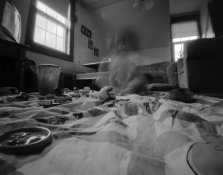NathanBell
Member
Hey All,
I'm becoming very interested in pinhole photography and am considering desinging and building a 5x7 camera.
Almost all of my applications would require a high shutter speed (of say 1/125) so I'm wondering if decent exposure at this high shutter speed is possible?
Getting a shutter to work that fast shouldnt be a problem, as I'll modify a shutter system from an old SLR and fit it to the pinhole (I'm a fitter machinist by trade, so I like building/destroying things)
I'm just woried that with such a high shutter speed that it wont expose the negative enough.
I was thinking of using Ilford HP5 400asa 5x7 Sheet film. Pushed if nessessary.
Is this at all possible?
I'm becoming very interested in pinhole photography and am considering desinging and building a 5x7 camera.
Almost all of my applications would require a high shutter speed (of say 1/125) so I'm wondering if decent exposure at this high shutter speed is possible?
Getting a shutter to work that fast shouldnt be a problem, as I'll modify a shutter system from an old SLR and fit it to the pinhole (I'm a fitter machinist by trade, so I like building/destroying things)
I'm just woried that with such a high shutter speed that it wont expose the negative enough.
I was thinking of using Ilford HP5 400asa 5x7 Sheet film. Pushed if nessessary.
Is this at all possible?













 )
)

